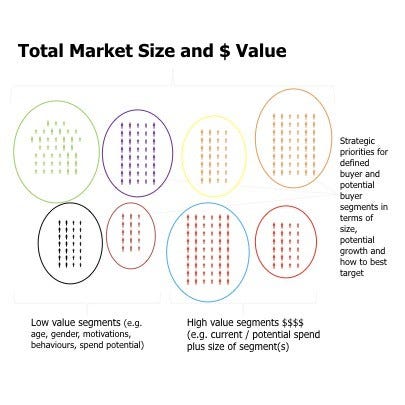How to segment a market (beyond assumption)
Likely the biggest driver to strategic success is the ability to accurately assess the size of a market, its needs and the optimal path to growth. From this comes strategies to attract desirable customers.
At the simplest level it is quite simple to segment a market. A new food product would likely target main grocery buyers, and a craft beer would target beer consumers. Similarly an anti-smoking government message would likely target smokers and road safety campaign drivers. Assumptions can be made as to the typical profile of the target market by age, gender and other demographic characteristics.
However, much of the assumption as to how markets are segmented are based more so on gut feel, replicating competitors, what they have previously done and/or observations of a small cohort of customers, friends, workmates and family.
The target market can be defined incorrectly based on assumptions, without any evidence. While some success may be had in making assumptions on the category norm, likely this results more so in sharing the pie with a large number of competitors or missing a significant pool of potential customers. Rather than maximising the customer base. A product so niche in its appeal, it fails to gain any real market traction. Or, an advertising campaign defining the target market so narrow and off reality that only a minuscule slice of potential customers find it relevant or even see it.
There many examples of successful strategies redefining the target market successfully. A food product that targets main grocery buyers, but also non-grocery shopping food lovers or amateur cooking enthusiasts just needing simpler steps to preparation. Or, a beer targeting traditional consumers, but also potential consumers who just needed the right product and to be asked. While a campaign targeting smokers to quit smoking and drivers to obey the speed limit, widening this to target other audiences such as children, families and mates are likely to have a much greater impact. Products and diverse as opera to gin, lotteries products to customised number plates, chocolates, to tech, cricket, football, arts companies and even political parties will struggle to survive solely catering to a saturated traditional market, they prosper from redefining target customer segments.
Further to this, assumptions can be made as to the typical needs of current and potential customer segments. Based on customer feedback and observation, a mental profile of the typical customer may be built, which likely misses niche segments of customers representing higher current and potential value. The squeaky customer likely gets the most attention, yet they likely may not the most valuable against other less obvious segments.
While a level of customer segmentation may be possible via a suitable CRM system, wider psychological and behavioural market segmentation typically requires access to more difficult to find data. Secondary research reports as to the profile of categories may exist. However, these may be inconsistent with the targeted market and/or wider product and business strategy.
Statistical analysis methodology cluster analysis is widely used to define segments based on behavioural, demographic, attitudinal, spend and other data from market and customer statistically representative surveys and, when possible, integrated with other data such as customer CRM and sales data to provide deeper and wider insight.
There are a number of approaches to conducting segmentation to find unique segments of the community. This includes approaches such as Cluster Analysis which is a statistical technique.
“Cluster analysis is an exploratory data analysis tool which aims at sorting different objects into groups in a way that the degree of association between two objects is maximal if they belong to the same group and minimal otherwise.”
Cluster analysis is an exploratory data analysis tool which aims at sorting different members of a sample population into groups in a way that the degree of association between those within a segment is maximal if they belong to the same group and minimal otherwise.
Survey (and other available) data is analysed by a statistician using an advanced statistical package such as SPSS. Cluster analysis typically utilises attitudinal, behavioural and/or demographic survey and other data to define 4-8 unique segments able to be targeted. This may be segments offering higher priority based on size, needs and/or current and potential spend, and how to best tailor communications and products to them.
Mapping the key segments of customers and potential customers provides a valuable opportunity to size and target the total market and valuable niche segments independently. For example, the likely incentives, triggers and content likely to gain the most positive outcome for the total market and/or niche segments. This will allow for consistencies across the population to be identified and where tailored strategies and information may be beneficial.
This provides analysis including the overall market size (i.e. market value, number of customers and market share of competitors); relative potential of market segments (i.e. which segments are the largest by current and potential value size, spend, frequency of spend and other variables); unique needs in terms of product, pricing etc; and strategic priorities (i.e. media consumption / impact, distribution etc).

What are the consistent truths irrespective of market segment, and may be valuable in a broader market message, and how can high potential niche segments be optimally targeted and revenue maximised? How do differing segments currently perceive the market competitors differentiate? What is the optimal target market for the advertising and media strategy?
Typically businesses humanise the market segments (i.e. bring them to creative life) via visual and data design, combining the quantitative data from various sources, defining segments via cluster analysis and then conducting qualitative research including focus groups, affinity and in-home discussions, ethnography, semiotics and other analysis of cultural and consumer patterns and trends to provide greater strategic empathy and a platform for revenue management.
Balancing the statistical rigor with creative interpretation brings the market segments to life as a clear point of visualisation. Segmentation allows for greater understanding of the communications needs of all segments of customers based on understanding and attitudes towards the issues.
With such robust segmentation market entry, innovation and growth strategies can be implemented without incorrect assumption and replicating the category norm or traditional target consumers. This allows a great level of strategic positioning, differentiation and precision likely otherwise.
You can find a bit more information from Square Holes on segmentation, including examples of outputs via here. Or, please contact Square Holes for more information.




